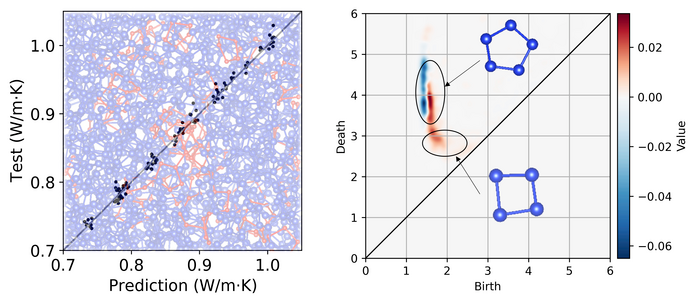Reviewed by Alex SmithJun 27 2022
Topological mathematics and machine learning have been utilized by theoretical scientists to determine a concealed relationship between thermal conductivity and nano-scale structures in amorphous silicon. It is a glassy form of the material with no repetitive crystalline order.
 Left: correlation between predicted values by the persistent homology analysis and test values which were evaluated by simulations. Right: data points (red and blue regions) on the persistent diagram strongly correlated to the values of thermal conductivity. A five-vertex cycle shown on the diagram is the minimum component of the medium-range order, and a four-vertex cycle is the component that breaks the medium-range order and lowers the thermal conductivity. Image Credit: National Institutes of Natural Sciences/Institute for Molecular Science.
Left: correlation between predicted values by the persistent homology analysis and test values which were evaluated by simulations. Right: data points (red and blue regions) on the persistent diagram strongly correlated to the values of thermal conductivity. A five-vertex cycle shown on the diagram is the minimum component of the medium-range order, and a four-vertex cycle is the component that breaks the medium-range order and lowers the thermal conductivity. Image Credit: National Institutes of Natural Sciences/Institute for Molecular Science.
A study explaining their method appeared in the Journal of Chemical Physics on June 23rd, 2022.
Amorphous solids, like glass, wax, plastics, and obsidian have no long-range repeating, or crystalline structure, to the atoms or molecules that they are made from. This differs from crystalline solids, like most metals, salt, and rocks. Since they run short of long-range order in their structure, the thermal conductivity of amorphous solids could be significantly less compared to a crystalline solid made of the same material.
But there could still be the availability of a few medium-range orders on the scale of nanometers. This medium-range order must impact the diffusion and propagation of atomic vibrations, which tend to carry heat. The heat transport caused by disordered materials is of unique interest to physicists as a result of its significance in industrial applications.
The amorphous form of silicon has been utilized in a huge range of applications in the present-day world, ranging from solar cells to image sensors. For this reason, scientists have intensively examined the structural signature of the medium-range order in amorphous silicon and how it pertains to thermal conductivity.
For better control over applications that make use of amorphous silicon, controlling its thermal properties is high on engineers' wish list. Extracting the nano-scale structural characteristics in amorphous including medium-range order is an important key.
Emi Minamitani, Study Corresponding Author and Theoretical Molecular Scientist, Institute for Molecular Science, National Institutes of Natural Sciences
Apparently, this task has proven to be challenging for researchers due to the difficulty of using conventional methods to identify the key nano-scale characteristics of disordered systems.
In experiments, the existence of medium-range order has been detected in a physical manner with the help of fluctuation electron microscopy. This includes statistical analysis of scattering from nano-scale volumes of a disordered material.
As far as the theoretical level is concerned, it has been discussed by taking the distribution of dihedral angles into account (the angle between two sectioning planes between sets of atoms) or utilizing so-called “ring statistics.” The latter tries to comprehend the structural characteristics from the linking of atoms.
This draws on the field of mathematics called topology, thereby analyzing properties of an object that do not change—or are known as “invariant”— even when the object is constantly subjected to stretching and deformed without being broken (like shapes written on a rubber sheet).
Concentrating on this topological invariance seems to be beneficial for providing a qualitative description, like the tendency of the physical properties concerning the randomness. But it is hard to identify the atomic structure equivalent to a medium-range order and forecast its physical properties obtained only from simple topological invariants.
Hence, the scientists pivoted to an evolving method known as persistent homology - a kind of topological data analysis. Persistent homology has been utilized in other places to examine complicated structures varying from proteins to amorphous solids.
The advantage of this technique is in detecting topological features in complex structures at various spatial scales. This is crucial since the medium-range order consists of quasi-repetitive structures at numerous scales. With this characteristic, it is possible to extract the medium-range order that has been hidden underneath what otherwise appears as randomness.
Computational models of amorphous silicon were constructed by the scientists with the help of classical molecular dynamics wherein the temperature of the silicon was raised over the melting point and further cooled gradually (quenching) to room temperature. Variations in structural characteristics were initiated by altering the cooling rate.
Furthermore, the firm diagram, which is the two-dimensional visualization of firm homology, was computed for every model. The scientists concentrated on diagrams that tend to reflect the structural features of amorphous silicon.
Hence, they built the numerical representation, known as “descriptors,” that could be utilized in machine learning. The scientist discovered that the persistent diagram satisfied the making of a good descriptor for use in the machine learning procedure, which in return helped achieve precise predictions regarding the thermal conductivities.
By additionally examining the stable homology data and machine-learning model, the scientists demonstrated the earlier hidden relationship between medium-range order in amorphous silicon and also its thermal conductivity.
Currently, the study must set the stage for an avenue for regulating material characteristics of amorphous silicon and also other amorphous solids via the topology of their nanostructures.
Journal Reference:
Minamitani, E., et al. (2022) Topological descriptor of thermal conductivity in amorphous Si. The Journal of Chemical Physics. doi.org/10.1063/5.0093441.